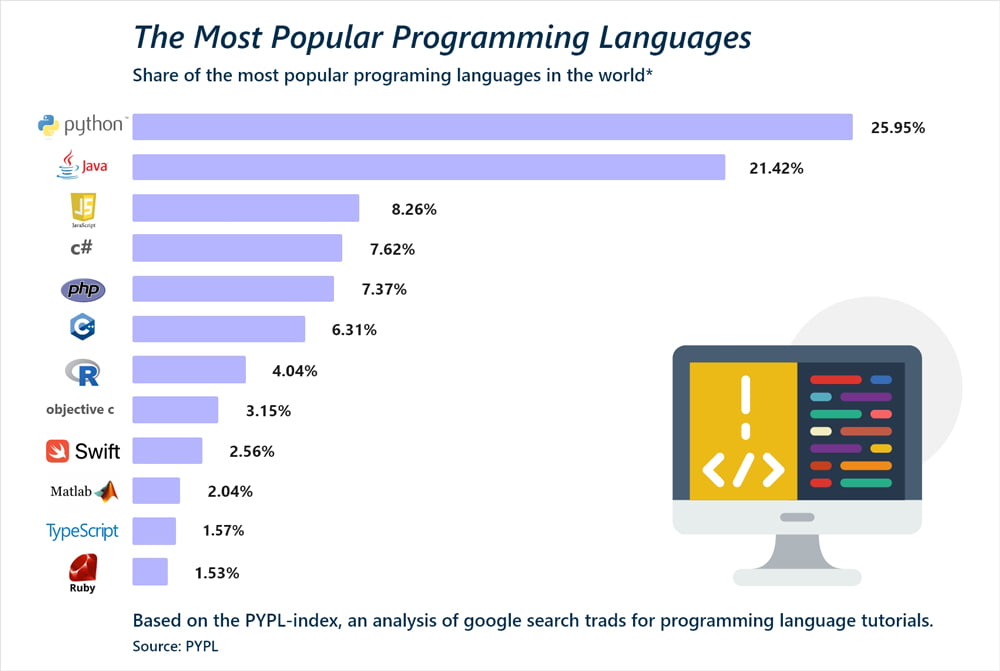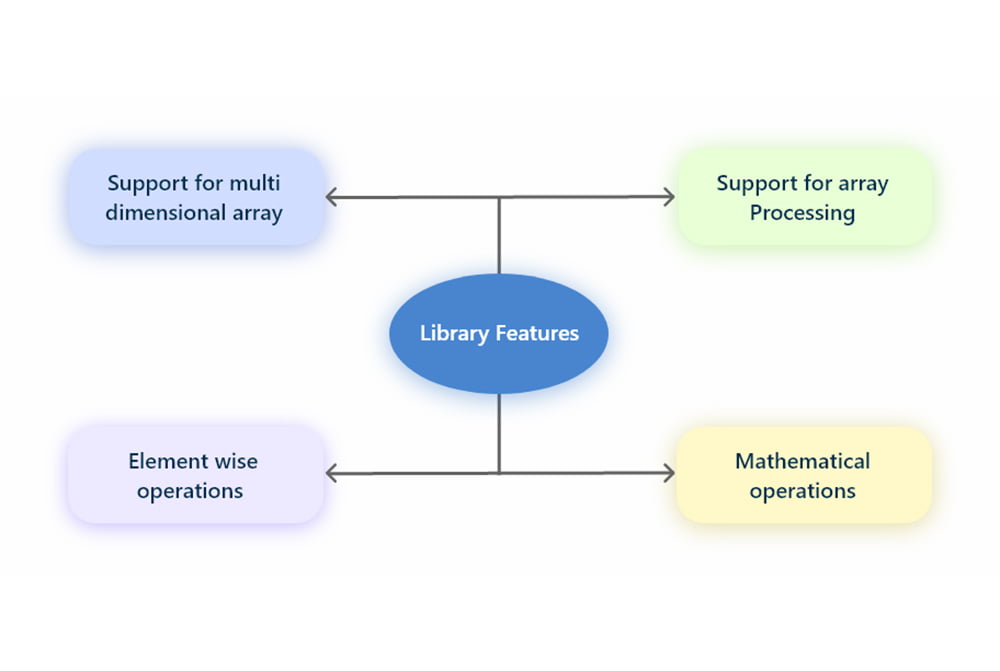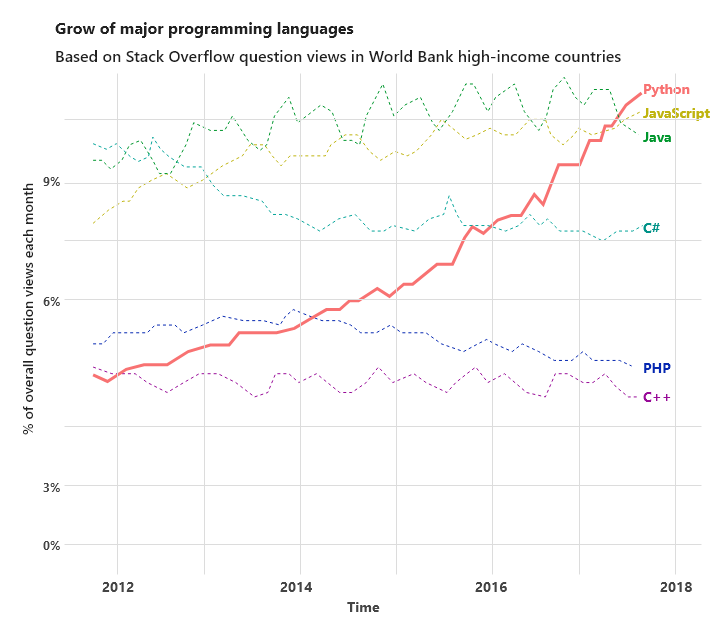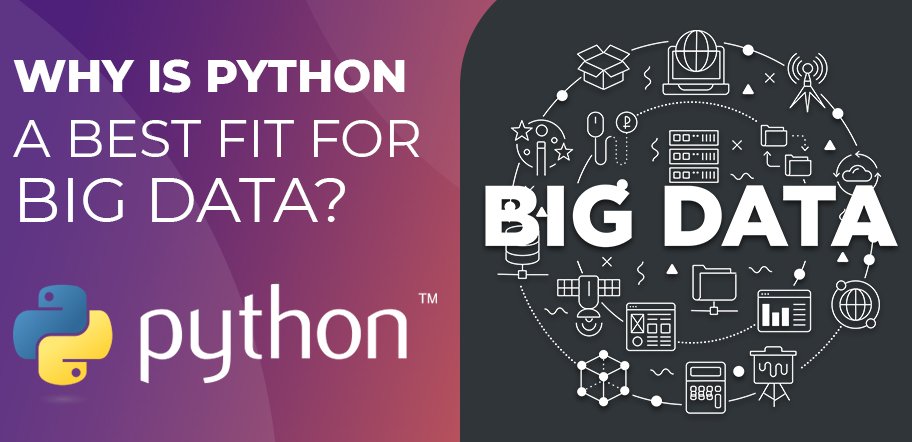“Python Language Is One Example. As We Noted Above. It Is Also Heavily Used For Mathematical And Scientific Papers. And Will Probably Dominate That Niche For Many Years Yet. – Eric S. Raymond”
Wherever you go, Python is everywhere!
So, Why is Python a best fit for Big Data?
Python is designed in a way that is easy to write and read. Not being a complex language, gives it the benefit of more usage. According to Stack Overflow Trend, Python is acknowledged as the fastest-growing programming language.
Today, Python is taking over the world in its best way. Python takes the Top spot for the fourth time as Most Popular Technologies in 2020. According to the responses of more than 60,000 developers around the world, Python is considered as the third “most loved” programming language.
Python is an interpreted, open-source, general-purpose, and object-oriented programming language. creating the world’s top applications such as Instagram, Google, Spotify, Uber, Pinterest, Reddit, etc.
Big data is the most precious commodity in this era. Someone said that “The Future of IT is Big Data”, well that is true, but how?
Let’s start with the basics of “What exactly Big Data is?”.
“Big Data is a huge cluster of data that is enormous in size and volume.”
The raw data comes with a large size and numerous complexity that no traditional tool can store, handle, and process it precisely. In short, Big data is data of large size.
Big size companies possess a huge bundle of data, where processing, and analyzing it can take a pretty much large amount of time, and the results may not be precise. Selecting a programming language for Big Data is a project-specific task, that depends on its goal. It doesn’t matter what projects, Python is best fit for Big Data.
But Why Python for Big Data?
When people started combining Python and Big Data, the scenario of the marketplace changed and now, Big Data is much more efficient and easy to understand, because Python has made it easy to use and understandable for every developer. Python is in enormous demand among all Big Data Companies right now.
Here, we will discuss why using python for Big Data is beneficial.
#1 Open- Source
Open source is software in which the original code is released under a license. This code can be altered, modified, and enhanced according to developers needs.
Python is an Open source programming language, thus, it supports multiple platforms. Python also supports environments like Linux, Windows, and MacOS.
Instead of wasting time in technical terms of language, the simple, clean, and readable syntax helps Big Data experts to focus on case managing Big data easily. This is one of the main reasons to opt for Python for Big Data.

#2 Simple and Minimal Coding
Minimal codes in Python programming make it extensively used, compared to other languages that are available for programming. Python is known for its execution in a few lines of code. Moreover, it automatically provides help to associate and identify various data types.
If you or someone has an idea, all you have to do is think and write 5-10 lines of code and there you go! Your program is ready to use.
This programming language follows an indentation-based nesting i.e. structure instead of braces to structure any program in it. This language can bear a heavy and complicated task in just a click of time. That data computes in commodity machines, clouds, desktop, and laptop.
In the beginning, python was considered a slow language compared to its equivalents like Scala and Java. Now, the scenario has taken a turn of 360 since then.
When Anaconda platform arrived in market, it came with a great speed to analyze the code. This is why Python for Big Data became the best option for everyone.
Your Python project works best when you Hire Python Developer who can add the essence and benefits of python in your business.
#3 Speed
Python is highly popular for its high speed to analyze the code and for software development. The precision of Python to analyze code is perfect, because of that Python is the most appropriate choice for Big Data. It supports prototyping ideas that help to make the code run faster.
While doing so, Python also maintains the transparency between the process and the code.
After Anaconda entered the market, the whole scenario of working on python language changed. It came with a speed that made everything in it useful. Python programming makes sure that the code is transparent and readable.
Such speed made python more powerful, and Big Data can use that speed to make the development faster.
#4 Libraries of Python for Big Data
Python offers a large set of standard libraries that includes corners like stings operations, internet protocols, operating system interface, and web service tool.
The standard library sets contain frequently used programming languages to make coding easier and smaller.
Python provides multiple useful libraries of your wish. This makes Python a famous programming language in the area of scientific computing.
Big data, as the word suggests, it involves a huge amount of data analysis and computation. These libraries make the work easier for Big Data Analytics.
Python offers numerous pre-tested analytics libraries. Big Data Analytics uses these libraries filled with packages, such as:
- Data Analysis: Inspecting, cleaning, modeling, and transforming any size of data (Large or Small) to discover some useful information for predicting the future of business on the basis of current information.
- Statistical Analysis: It is the process of collecting and analyzing the data, in order to analyze the trend and pattern.
- Machine Learning: As the name suggests, ML is programming a computer in such a way that it learns everything from different kinds of data on its own. Machine Learning uses python libraries like Numpy, Scikit-learn, Theano, TensorFlow, Keras, Pandas, PyTorch, and Matplotlib.
- Numerical Computing: Scientific computation is done by this. Scientific computing contains Scipy, Pandas, IPython, Natural language Toolkit, and Numeric python.
- Data Visualization: It gives many insights that data alone cannot provide. When you visualize the information, you bring your mind into the landscape that you explore with your eyes, like an information map in front of your eyes. Visualization libraries contain Matplotlib, Plotly, Seaborn, ggplot, and Altair.

#5 Compatibility of Python with Hadoop
Hadoop’s framework is made using Java programming language. Hadoop programs also use C++ and Python. It means that even if the data architects don’t know anything about java, they can use python as an option. When you compare Java with Python, it is much easier to use python because of its small codes and high speed.
Compared to other programming languages, Hadoop is more compatible with python. You can incorporate all the features into your business. For this, you will have to Hire Python Developer who is good with the skills.
About Pydoop Package
Pydoop package is an interface of python to hadoop that gives you authority to write MapReduce applications and interact with HDFS applications in python.
HDFS API let’s you write and read different information on directories, global file system properties without facing any problem.
Pydoop provides MapReduce API for solving tough and complex problems with minimal programming. This API implements advanced data science concepts like ‘Record Reader’ and ‘Counter’, which makes Python the best fit for Big Data.
#6 Data Processing Support
Python comes with an inbuilt feature of supporting data processing. Data processing for unconventional and unstructured data. uses this feature. This is the main reason why big data analytics companies choose python over every option.
#7 Scope of Python for Big Data
Python is an object-oriented language that supports high-level data structures. It allows users to simplify all data operations. Python manages some of the data structures i.e. lists, dictionaries, tuples, sets, etc. Other than this, Python also supports scientific computing operations such as data frames, matrix operations, etc.
These astonishing features of Python help to enhance the scope of language by enabling it to increase speed of data operations. This makes Python and Big Data the most charming and useful combination. That’s why python a best fit for Big Data.

Before We Apart
Now, You may have a clearer picture in front of you now about why Python is best fit for Big Data. To understand it more clearly, you will have to go deep into it and understand every single bit of it because Big Data is like a star in the universe, no matter how far you go, it will never reach its limit of learning.
“Data is a precious thing and will last longer than the systems themselves.”- Tim Berners-Lee
Big Data technology is spreading across the world, people are learning and advancing themselves every day. It can be a very flinty task, but knowing why Python a best fit for Big Data will for sure help you make your way through learning Big data using Python.

Mitesh Prajapati
Mitesh Prajapati is Co-founder of LogicRays Technologies; he is known for connecting people to power by serving his unique abilities in various technologies to help businesses grow to the next level. Running a leading Web & App development company is not the only thing he is best at; with this, he’s been serving his expertise in Mobile App Development since more than 5 years now. He covers main areas like Android, iOS, React Native, and Flutter, to all the businesses that need growth by offering the best to their clients.
Subscribe To Our
Newsletter
Know The Technology!
Sign up today!
